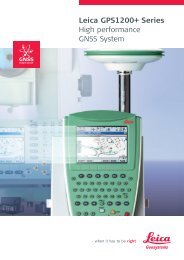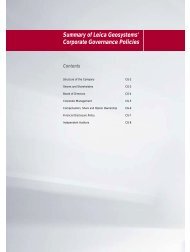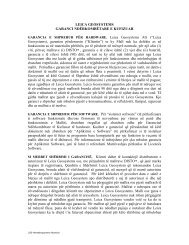The Global Magazine of Leica Geosystems
The Global Magazine of Leica Geosystems
The Global Magazine of Leica Geosystems
Create successful ePaper yourself
Turn your PDF publications into a flip-book with our unique Google optimized e-Paper software.
12 | Reporter<br />
Laser Land Levelling<br />
by Raymond Chia<br />
<strong>The</strong> economical benefits <strong>of</strong> perfectly levelled<br />
fields are enormous, especially in India. For<br />
instance, a levelled field results in substantial<br />
watersavings and an increase in yield and product<br />
quality. Rotating lasers have become essential<br />
tools for agricultural applications. <strong>The</strong>y make<br />
faster work <strong>of</strong> many jobs, while eliminating costly<br />
errors for precise levelling. Once considered “nice<br />
to have,” today they are a competitive “must have”<br />
to get the job done efficiently and precisely.<br />
Uneven soil surface has a major impact on the germination,<br />
stand, and yield <strong>of</strong> crops due to inhomogeneous<br />
water distribution and soil moisture. <strong>The</strong>refore,<br />
land levelling is a precursor to good agronomic,<br />
soil, and crop management practices. Furthermore,<br />
resource conservation technologies perform better<br />
on well-levelled and laid-out fields.<br />
Benefits <strong>of</strong> land levelling<br />
Effective land levelling optimises water-use, improves<br />
crop establishment, reduces the irrigation time and<br />
the effort required to manage the crop. It reduces<br />
the work in crop establishment and crop management,<br />
and increases the yield and product quality.<br />
Research has shown an increase in rice yield <strong>of</strong> up to<br />
24 percent due to good field levelling. A large part <strong>of</strong><br />
this increase is realized due to improved weed control.<br />
<strong>The</strong>refore, with the improved water coverage,<br />
resulting from proper levelling, the weeds can be<br />
reduced by up to 40 percent. In addition, land levelling<br />
frees up land for cultivation, resulting in larger<br />
fields and larger farming areas, which improves the<br />
operational efficiency. Furthermore, levelling reduces<br />
the time needed for planting and transplanting.<br />
It even gives a greater opportunity to use the much<br />
faster, direct seeding process.<br />
Efficiency <strong>of</strong> water use<br />
<strong>The</strong> average difference in height between the highest<br />
and lowest portions <strong>of</strong> rice fields in Asia is 160 mm.<br />
This means that in an unlevelled field an extra 80 mm<br />
to 100 mm <strong>of</strong> water must be stored in the field to<br />
give complete water coverage. This is nearly an extra<br />
10 percent <strong>of</strong> the total water requirement to grow<br />
the crop. Land levelling effectively terraces fields,<br />
allowing water in the higher fields to be used in the<br />
lower fields for land preparation, plant establishment,<br />
and irrigation.<br />
Economics <strong>of</strong> land levelling<br />
<strong>The</strong> initial cost <strong>of</strong> land levelling using contractor sand<br />
machinery is high. This cost varies with the volume<br />
<strong>of</strong> soil to be moved and the soil type. However, using

















